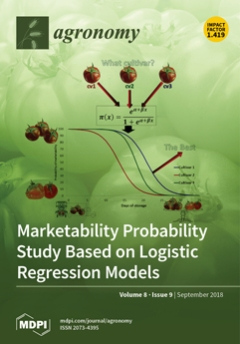In recent years, awareness on sustainable land use has increased. Optimizing the practice of nitrogen fertilization has become crucially imperative in cropping management as a result of this current trend. The effort to improve the availability of organic nitrogen has incurred a bottleneck while seeking to achieve a high yield and quality performance for organic winter cereals. Field experiments were conducted, under rainfed Mediterranean conditions, over a period of two subsequent growing seasons. The objective was to investigate the effect of soil and foliar S application on the performance of three durum wheat cultivars fertilized with either organic or inorganic N. The hypothesis to be verified was if different S fertilization strategies could improve grain yield and quality when coupled with mineral or organic N fertilizer. There were three levels of treatment with mineral N fertilizer (120, 160 and 200 kg ha
−1), two levels of organic N fertilizer (160 and 200 kg ha
−1), two levels of S fertilizer applied to the soil (0 and 70 kg ha
−1), and two levels of foliar S application at flag leaf stage (0 and 5 kg ha
−1). Cultivars were Dylan, Iride and Saragolla. Analyzed traits were grain yield, yield components and quality features of grain. Overall, at the same N rate, grain yield and quality were markedly higher for mineral than organic N source. Cultivar × Year × N treatment interactions significantly affected grain yield and quality indices. Iride showed a high yield stability throughout the mineral N rates in the most favorable year (2011) and, in the same year, was the top performing cultivar in organic N treatments. Dylan was the top performing cultivar for protein content, while Saragolla for the SDS sedimentation test. Soil S fertilization had no effect on grain quality, whereas it significantly increased grain yield (+ 300 kg ha
−1) when coupled with organic rather than a mineral N source. However, foliar S application at flag leaf stage did not affect grain yield, but it significantly enhanced quality indices such as test weight (81 vs. 79.9 kg hL
−1), protein content (13.7% vs. 12.9 %) and SDS value (72.5 vs. 70.5 mm). A rate of 160 kg ha
−1 of N (both mineral and organic) determined the optimal response for both grain yield and quality. Finally, soil and foliar application of S may help to contain the large yield and quality gap that still exists between mineral and organic fertilization of durum wheat.
Full article





